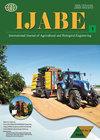大疆T30六旋翼植保无人机下洗气流场分布特性及其对喷淋场分布的影响
IF 2.2
2区 农林科学
Q2 AGRICULTURAL ENGINEERING
International Journal of Agricultural and Biological Engineering
Pub Date : 2023-01-01
DOI:10.25165/j.ijabe.20231602.8094
引用次数: 2
摘要
:喷雾特性是影响液滴向下运移、沉积和漂移的根本因素。无人机的下洗气流场主要通过改变喷雾特性来影响液滴的沉积和漂移。本文主要研究了无人机下洗气流场和喷嘴位置对雾滴空间分布和速度分布的影响,这是影响喷雾特性的两个因素。为了研究上述特性,采用基于晶格玻尔兹曼方法(LBM)的计算流体力学方法,对大疆T30六旋翼植保无人机在不同旋翼转速(1000 ~ 1800 r/min)下的下洗气流场进行了仿真。利用粒子图像测速系统(PIV)记录不同转子转速(0 ~ 1800 r/min)和不同喷嘴位置(距离电机0、0.20 m、0.35 m、0.50 m)下洗气流场的喷雾场。仿真和实验结果表明,转子下洗气流场呈现“分散-收缩-再分散”的发展规律。在旋翼气流弥散初期,旋翼下洗气流场中存在明显的高涡度区和低涡度区。低涡度区主要集中在电机下方,高涡度区主要集中在转子中部。Y向气流速度在转子下方0.4 ~ 1.2 m处有波动。当转子气流发展到转子以下3.2 m时,Y方向气流速度略有下降。在距转子3.2 m以上,Y向气流速度开始急剧下降。因此,建议大疆T30植保无人机在进行田间喷洒作业时,飞行高度不要超过3.2 m。旋翼下洗气流场使旋翼系统启动时喷嘴雾化角减小,液滴浓度减小,喷雾场宽度减小,喷雾场涡流规模增大。而转子转速的增加则促进了上述趋势。当喷嘴安装在转子下方不同径向位置时,液滴的空间分布和速度分布完全不同。当喷嘴安装在电机正下方时,液滴的空间分布和速度分布相对对称。当喷嘴安装在距离电机0.20 m和0.35 m处时,液滴在较强转子涡的诱导下明显向右移动。这导致右半喷雾区液滴浓度较高。然而,当喷嘴安装在转子尖端时,液滴向左移动。对于四个喷嘴位置,当喷嘴安装在距离电机0或0.20 m处时,液滴的平均速度要高得多。而当喷嘴安装在另外两个位置时,液滴平均速度较慢。因此,建议将喷嘴安装在距离电机0或0.20 m处。研究结果可以加深对无人机下洗气流场分布特性及其对液滴空间分布和速度分布特性的影响的认识。同时,研究结果可为转子下方喷管位置的选择提供一定的理论指导。本文章由计算机程序翻译,如有差异,请以英文原文为准。
Downwash airflow field distribution characteristics and their effect on the spray field distribution of the DJI T30 six-rotor plant protection UAV
: Spray characteristics are the fundamental factors that affect droplet transportation downward, deposition, and drift. The downwash airflow field of the Unmanned Aviation Vehicle (UAV) primarily influences droplet deposition and drift by changing the spray characteristics. This study focused mainly on the effect of the downwash airflow field of the UAV and nozzle position on the droplet spatial distribution and velocity distribution, which are two factors of spray characteristics. To study the abovementioned characteristics, computational fluid dynamics based on the lattice Boltzmann method (LBM) was used to simulate the downwash airflow field of the DJI T30 six-rotor plant protection UAV at different rotor rotational speeds (1000-1800 r/min). A particle image velocimetry system (PIV) was utilized to record the spray field with the downwash airflow field at different rotational speeds of rotors (0-1800 r/min) or different nozzle positions (0, 0.20 m, 0.35 m, and 0.50 m from the motor). The simulation and experimental results showed that the rotor downwash airflow field exhibited the ‘ dispersion-shrinkage-redispersion’ development rule. In the initial dispersion stage of rotor airflow, there were obvious high-vorticity and low-vorticity regions in the rotor downwash airflow field. Moreover, the low-vorticity region was primarily concentrated below the motor, and the high-vorticity region was mainly focused in the middle area of the rotors. Additionally, the Y -direction airflow velocity fluctuated at 0.4-1.2 m under the rotor. When the rotor airflow developed to 3.2 m below the rotor, the Y - direction airflow velocity showed a slight decrease. Above 3.2 m from the rotor, the Y -direction airflow velocity started to drastically decrease. Therefore, it is recommended that the DJI T30 plant protection UAV should not exceed 3.2 m in flight height during field spraying operations. The rotor downwash airflow field caused the nozzle atomization angle, droplet concentration, and spray field width to decrease while increasing the vortex scale in the spray field when the rotor system was activated. Moreover, the increase in rotor rotational speed promoted the abovementioned trend. When the nozzle was installed in various radial locations below the rotor, the droplet spatial distribution and velocity distribution were completely different. When the nozzle was installed directly below the motor, the droplet spatial distribution and velocity distribution were relatively symmetrical. When the nozzle was installed at 0.20 m and 0.35 m from the motor, the droplets clearly moved toward the right under the induction of stronger rotor vortices. This resulted in a higher droplet concentration in the right-half spray field. However, the droplet moved toward the left when the nozzle was installed in the rotor tip. For four nozzle positions, when the nozzle was installed at 0 or 0.20 m from the motor, the droplet average velocity was much higher. However, the droplet average velocity was slower when the nozzle was installed in the other two positions. Therefore, it is recommended that the nozzle is installed at 0 or 0.20 m from the motor. The research results could increase the understanding of the downwash airflow field distribution characteristics of the UAV and its influence on the droplet spatial distribution and velocity distribution characteristics. Meanwhile, the research results could provide some theoretical guidance for the choice of nozzle position below the rotor.
求助全文
通过发布文献求助,成功后即可免费获取论文全文。
去求助
来源期刊

International Journal of Agricultural and Biological Engineering
AGRICULTURAL ENGINEERING-
CiteScore
4.30
自引率
12.50%
发文量
88
审稿时长
24 weeks
期刊介绍:
International Journal of Agricultural and Biological Engineering (IJABE, https://www.ijabe.org) is a peer reviewed open access international journal. IJABE, started in 2008, is a joint publication co-sponsored by US-based Association of Agricultural, Biological and Food Engineers (AOCABFE) and China-based Chinese Society of Agricultural Engineering (CSAE). The ISSN 1934-6344 and eISSN 1934-6352 numbers for both print and online IJABE have been registered in US. Now, Int. J. Agric. & Biol. Eng (IJABE) is published in both online and print version by Chinese Academy of Agricultural Engineering.
 求助内容:
求助内容: 应助结果提醒方式:
应助结果提醒方式:


